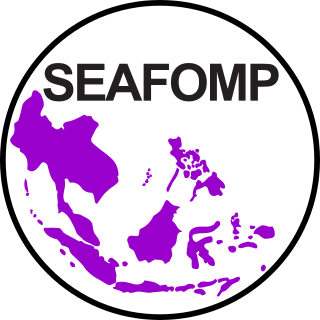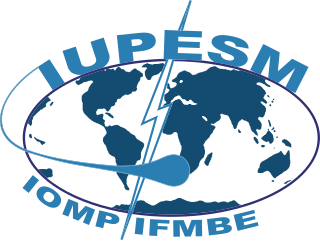Medical physics deals with the application of the concepts and methods of physics to the prevention, diagnosis and treatment of human diseases with a specific goal of improving human health and well-being. Since 2008, medical physics has been included as a health profession according to International Standard Classification of Occupation of the International Labour Organization.

The Council for International Organizations of Medical Sciences (CIOMS) is an international non-governmental organization of 40 international, national, and associate member groups representing the biomedical science community. It was jointly established by the World Health Organization (WHO) and United Nations Educational, Scientific and Cultural Organization (UNESCO) in 1949 as a successor to the International Medical Congress that organized 17 conferences from 1867 until the 1913 outbreak of World War One.

The Institute of Physics and Engineering in Medicine (IPEM) is the United Kingdom's professional body and learned society for physicists, engineers and technologists within the field of medicine, founded in 1995, changing its name from the Institution of Physics and Engineering in Medicine and Biology (IPEMB) in 1997. The Institute is governed by an elected Board of Trustees reporting to which are the Science, Research and Innovation Council and the Professional and Standards Council. The councils have operational responsibility for scientific and professional aspects of the Institute's work, respectively. Beneath the councils is a substructure of committees, groups and panels of members, which undertake the work of the Institute.

The International Organization for Medical Physics (IOMP) is a professional organization for medical physics with nearly 22,000 members in 84 countries.

Medical & Biological Engineering & Computing is a monthly peer-reviewed medical journal and an official publication of the International Federation of Medical and Biological Engineering. It is published by Springer Science+Business Media. It covers research in biomedical engineering and bioengineering. It was established as a bimonthly publication in 1963 under the title Medical Electronics & Biological Engineering. It publishes Original Research Articles, Reviews, and Technical Notes.

South East Asian Federation of Organizations for Medical Physics (SEAFOMP) was officially formed when it was accepted as a regional chapter of the International Organization for Medical Physics (IOMP) at the World Congress on Medical Physics and Biomedical Engineering, held in Chicago, Illinois, in 2000.

The International Union for Physical and Engineering Sciences in Medicine (IUPESM) is an international non-governmental organization - the umbrella organization for the International Organization for Medical Physics (IOMP) and International Federation of Medical and Biological Engineering (IFMBE).
Per "Åke" Öberg, born 1937 in Härnösand, is a Professor of Biomedical Engineering at Linköping University, Sweden.
The International Academy of Medical and Biological Engineering (IAMBE) is a non-profit society of distinguished scholars engaged in medical and biological engineering research to further the field of biomedical engineering or bioengineering. The academy is composed of Fellows who have made significant contributions to and played leadership roles in the field of medical and biological engineering. The academy is affiliated with the International Federation for Medical and Biological Engineering (IFMBE), an international organization consisting of more than 60 national and transnational societies of biomedical engineering, representing over 120,000 members.

The World Federation of Engineering Organizations is an international, non-governmental organization representing the engineering profession worldwide.

The Canadian Medical and Biological Engineering Society (CMBES) is a technical society representing the biomedical engineering community in Canada. CMBES is supported by its membership which consists of biomedical engineers, biomedical engineering technologists and students. CMBES also hosts an annual conference and regular webinars. It produces a number of publications including the Clinical Engineering Standards of Practice and a Newsletter. The Society's aims are twofold: scientific and educational: directed toward the advancement of the theory and practice of medical device technology; and professional: directed toward the advancement of all individuals in Canada who are engaged in interdisciplinary work involving engineering, the life sciences and medicine.
Slavik Tabakov is a British-Bulgarian medical physicist, President of the International Organization for Medical Physics (IOMP) 2015-2018 and Vice-President of the International Union for Physical and Engineering Sciences in Medicine (IUPESM) 2018-2021. He has made significant contributions to the development and global dissemination of medical physics education and training and has pioneered e-learning in the profession.
Maryellen L. Giger, is an American physicist and radiologist who has made significant contributions to the field of medical imaging.
Philippa Ngaju Makobore is a Ugandan electrical engineer. She is the head of the instrumentation division at the Uganda Industrial Research Institute (UIRI).
Ricardo Luis Armentano Feijoo is an Uruguayan professor and researcher who has worked in biomedical engineering and cardiovascular systems. He currently serves as the director of the GIBIO research group at the National Technological University — Buenos Aires Regional Faculty (Argentina). Also he is the director of the Department of Biological Engineering, University of the Republic (Uruguay). He has two doctoral degrees, two post-doctoral degrees, and has authored more than 300 research articles and 20 books/book chapters.
The European Federation of Organisations for Medical Physics (EFOMP) was founded in May 1980 in London to serve as an umbrella organisation representing the national Medical Physics societies in Europe. The office moved to Utrecht in January 2021. It is a non-profit organisation and aims to foster and coordinate the activities of its national member organisations, encourage exchange and dissemination of professional and scientific information, develop guidelines for education, training and accreditation programmes and to make recommendations on the responsibilities, organisational relationships and roles of medical physicists.
Caridad Borrás is a Spanish medical physicist. Her career started in 1964 at the Santa Creu i Sant Pau Hospital in Barcelona. From 1988 to 2000, she was Regional Advisor of the Radiological Health Program and, from 2000 to 2002, Coordinator of Essential Drugs and Technology at the Pan American Health Organization in Washington D.C.

Ewart R Carson is a British chartered engineer, system scientist, author, and academic. He is a Professor Emeritus of Systems Science in the School of Science and Technology at City, University of London.









